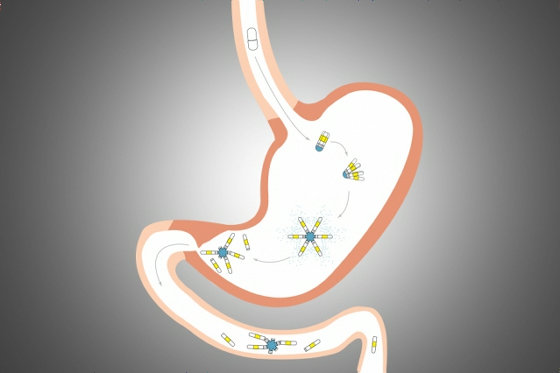What is the epoch-making mechanism for the development of contraceptives that continue to release drugs in the stomach for a month?

The problem with oral contraceptives is that they are not effective unless you take them regularly every day and at the same time. Has occurred. Therefore, a new researcher has developed a breakthrough contraceptive that once taken, it stays in the stomach and is effective for a month.
A once-a-month oral contraceptive | Science Translational Medicine
https://stm.sciencemag.org/content/11/521/eaay2602
Monthly birth control pill could replace daily doses | MIT News
http://news.mit.edu/2019/monthly-birth-control-pill-1204

Oral contraceptives are one of the most common methods of contraception, but you should take them at a fixed time every day to get a positive effect. Contraceptive success rate is said to decrease if there is a day when you do not take contraceptives or if the time is significantly shifted, and 9% of people who actually take oral contraceptives are pregnant every year It is estimated that.
Researchers at the Massachusetts Institute of Technology (MIT) are developing 'oral contraceptives that can be taken only once a month' to prevent pregnancy due to forgetting to take oral contraceptives. The new contraceptive contains three weeks of medicinal ingredients in a capsule coated with gelatin, and the capsule swallowed by a woman stays in the stomach and gradually releases the drug. This research is in the stage of animal experiments at the time of writing the article, and experiments with female pigs seemed to be as effective as daily oral contraceptives.
As normal oral contraceptives enter the stomach, they are dissolved in the stomach acid and exit the pylorus to the duodenum. This makes it impossible to stay in the stomach for a long time, and it is necessary to take medicine every day.
The team developed a mechanism to keep the drug in the stomach with a star-shaped device with six arms.

The star-shaped device has the arm folded inside the capsule, but once it enters the stomach, the coating is melted by the stomach acid and the arm expands. The device with the arm extended is about 5.4cm in length, which is larger than 2cm, which is the diameter of the pylorus, so it cannot get out of the stomach and stays effective for a long time. The device is not large enough to cause occlusion, and if the drug dissolves from each arm, the arm collapses and can pass through the pylorus.
The following diagram shows the star device process.

The system was originally developed by the team for malaria and HIV medicines, and is the first time it has been used as an approach to contraceptives. Researchers have also announced that this is the first time it has been effective for a long period of one month.
The research team, Robert Langer and other authors, experimented with two types of tablets in a total of six female pigs. The team looks at how much pigs release luteinizing hormone , a female hormone, with monthly contraceptives, and then compares the values with five female pigs taking daily type contraceptives Did. The results showed that pigs taking monthly oral contraceptives had the same level of luteinizing hormone as pigs taking daily contraceptives on day 21. In addition, X-rays confirmed that the star device was disassembled in a month, but the hormone level did not drop sharply at this time.
Associate professor Kimberly Skarsi of the University of Nebraska Medical Center, who has not participated in the study, said, “Inadequate access to contraceptives has caused global health problems such as unwanted death of pregnant women and newborns. “Monthly oral contraceptives greatly improve the medication problem and offer non-invasive contraceptive options for greater control over women's health and family planning decisions.”
Lyndra Therapeutics , founded by researchers, has received a $ 13 million grant from the Bill & Melinda Gates Foundation to conduct clinical trials, and it is still time for the drug to become widely available. However, it is expected that human inspection will be possible within the next 3-5 years.
Related Posts:
in Science, Posted by darkhorse_log







